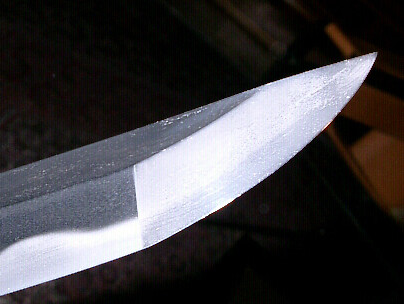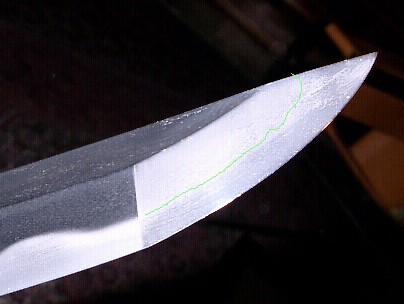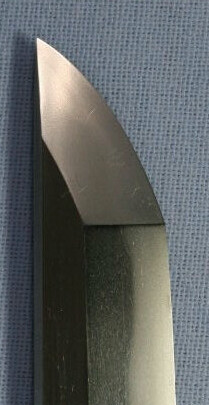
Tokaido
Members-
Posts
137 -
Joined
-
Last visited
Content Type
Profiles
Forums
Events
Store
Downloads
Gallery
Everything posted by Tokaido
-
Congratulation Andi, your translation is correct. :D Most Kiyotsuna are from Suwo, Nio school and Koto. I found one Kiyotsuna from Yamashiro Province in Hawley: Kiyo593 He Signed Yamashiro Kuni Fujiwara Kiyotsuna and Joshu ju Omi (no) Kami Fujiwara Kiyotsuna. Worked 1661 so the sword should show Kanbun characteristics. No entry in Fujishiro or Shinto Taikan found Greetings Andreas PS: more pics availiable?
-
Hello Klaus, please be aware that Hankei is a VERY famous smith from the early shinto period. Do you think a Japan based dealer would offer a sword signed "Hankei" for the price of a middle class shinsakuto if there would be a single grain of salt the possibility of beeing a genuine Hankei (and fetching a price 30 time the ebay price)? Of course not. Like Wim suggested before, look at the sword and compare the shown features with the known features of genuine specimen. This one: Shape is wrong, hada is wrong, hamon is wrong, deki is wrong, nakago looks like made yesterday morning and carefully *aged*, so little chance that this one is a genuine Hankei, judged from the pics. Greetings. Andreas
-
Hello Markus, the sword may bear a false signature (gimei) or not. Anyway it looks like a real Japanese sword, so it maybe useful to study the *handle and care* advice FIRST to avoid any damage to the blade and the owner/user http://www.nbthk-ab.org/Etiquette.htm Greetings Andreas It's a pain seeing the blades very tip resting on the wooden table . Sorry
-
Hello Rich, do not miss Tokugawa-art, this shop: http://www.sanmei.com It is only a five minute walk distance from the Tokugawa Art Museum. The friendly shop-owner Fukuoka-san speaks fluent english. In fall last year I experienced a warm welcome, enjoyed a nice talk and a dilicious tea. I also had a close look to the swords in the shop . Finally I was presented with a free entrance ticket for the Tokugawa Art museum :-) Greetings
-
samurai sword 1450-1550 a.d.
Tokaido replied to snatch13's topic in General Nihonto Related Discussion
Hi, some fuel for the fire: Do you call this nakago ubu? http://www.e-sword.jp/sale/2009/0910_3011syousai.htm Do the Hozon Kanteisho state that the shumei is genuine? Kind regards Andreas -
Hello, I wonder if anybody has allready looked at this ebay auction: 110391815684 Looks like a nice sword The horimono of the sankotsuka looks very *fresh* without abrasion from past polishes. Am I totally wrong to suspect, that a atobori horimono would have been noticed as *atobori* on the NTHK Kanteisho? Greetings
-
Dear friends of the nihonto, while browsing some of the old issues of the Token Bijutsu, I stumbled on a Shintogo Kunimistu Tanto (TB No 574) with a description of *nagare hada like asaysugi hada*. Since there is a foto of the blade, I realised a *very slightly* ondulating hada. Looking up other descriptions of Kunimitsu's tanto, I found several sources stating that *it is typical for SK to show some ayasugi like hada*. Since I had only hands-on-access to 3 different Kunimitsu tanto yet, I did not see his ayasugi in person. Or at least I did not recognise it Can anyone of you confirm the ayasugi hada in Kunimitsu tanto from your experience? Are there any good fotos availiable showing this feature in his work? Greetings Andreas B.
-
Hello Adam, the hamon is not very visible on your kissaki (maybe because of reflections or poor polishing job). Please have a look at this sample of a kissaki. The actual hamon is made up of ko-nie and follows the green line, but there are many nie scattered additionally within the hamon in nie-kuzure fashion (the maker is famous for this type of nie scattering within the hamon) Greetings Andreas B.
-
Hello Dan, you will get a leaflet with the list of the exhibited items. Unfortunately it is availiable in Japanese Kanji only. But every item in the display case has an english name on it (and there are only big names swords on display, so easy to read kanji So you may miss the (very short) descrition (in Japanese), but you can write down the swordsmiths names on your Japanese leaflet. Most times there is no englishspeaking staff availiable, sorry. Kind regards Andreas B.
-
Sano exhibit
Tokaido replied to John A Stuart's topic in Sword Shows, Events, Community News and Legislation Issues
Hy John, thank you for trying to get those pics. They were lovely, weren't they? Sonds like you met the same girl at the desk as we did a week ago Greetings Andreas BTW: to find the museum was easy for me: since I 'm a lazybone, I took a taxi from the railway station -
Hi John, best wishes for recovering and please don't forget the just started exhibition about Masamune, Muramasa etc in the Sano Museum in Mishima which will last until Dezember 21th. I visited on Thuesday and the swords are fantastic and the lighting is superb,much better than at Keio Plaza > Three Masamune (all better than at Keio Plaza), two Kunimitsu, two Hiromitsu Tanto, several blades of Shimada School (Yoshisuke etc) and of course the Muramasa blades. Unfortunately there is no catalogue availiable, but most swords are acompanied by large scale pictures AND are availiable at a PC Station in the showroom for magnified views. I wish I could get this pictures on my memorystick. Greetings Andreas
-
Kyu-gunto Russo-Japanese sword???? non sharp Need Help
Tokaido replied to Last-Samurai's topic in Nihonto
Hi Andreas, to get rid of the ebay blocking function, simply be sure to remove "GERMAN" as language in your browser and/or windoof system No abroad proxy etc needed. Greetings Andreas -
Kyu-gunto Russo-Japanese sword???? non sharp Need Help
Tokaido replied to Last-Samurai's topic in Nihonto
Hi Andreas, sorry, but this sword looks like a reproduction in my opinion. Reproduction of this type (and the shin gunto type) were sold during the last years for example by the German Company Frankonia. Clues: no same on the hilt but white leather, very bad ending of the hi in the tip, unsharpened blade, slightly rougher casting of the brass parts, if compared with the genuine items. Slightly better than the ugly chinese fakes, but still not the real thing. Greetings Andreas -
DTI/Taikai Tokyo 2008
Tokaido replied to Brian's topic in Sword Shows, Events, Community News and Legislation Issues
Hi Brian an Stephen, Five years ago I attended the Token Taikei. I guess there will be no mayor changes in the procedure/event: 1) It is for members of the NBTHK ONLY (second person = spouse etc.; not a member, not allowed to handle the swords). 2) The entrance fee is good for the viewing of the swords, the participating in the kantei session, a gift and the dinner at the evening. 3) There was a small leavelet listing the swords on exhibition, but no catalogue. The gift was a fukusa, a menuki-nuki and a book with some articles (in Japanese) of the Mishina School, Kunisada/Shinkai and others. As far as I understand, there will be no shinsa and you surely cannot bring your own swords to this event. In 2003 there were 168 blades in two rooms plus the kantei room (6? blades) and the shinsakuto room (approx a dozend blades). For the main rooms you stand in line and wait(and wait and wait). There is a "soundmachine" giving a whistle every 60 (?) seconds. Than you have to step forwards, grasp the sword in front of you, lift i up from the table, read the Japanese label on the table and look at the sword (<40 seconds). After the next whistle (60 seconds!) you put down the sword and move to the next one on the table. Amazing procedure Swords were of different quality up to juyobijutsuhin. Greetings Andreas -
Hi all, today I found this one on ebay: http://cgi.ebay.com/Hiromasa-Koto-Tanto ... dZViewItem Looking at the nakago (filemarks, mekugi ana) and the style of the signature I wonder, if this is a Soshu Hiromasa Utsushi dating from the Shinshinto period? Any ideas? Greetings Andreas
-
Hi, I think Thomas got a point here! If it is Hosho of late Kamakura Period or Nambokucho Period should'nt we see some more prominent nie in the hamon? If it is very late Hosho of Muromachi Jidai, I would expect the hada on the rougher side. If it is a shortened Wakizashi of late Hosho, we should probably expect higaki yasurime, so the sujikai yasurime would not fit if original. Did you find any masaware in the pictures? If no or very little are present, maybe Borax played allready a role during folding (=>shinto)? The sugata is not so obvious a clue of time in my opinion: If you have a greatly shortened late Kamakura shape, this would look very similar to a shortened Kanei-Shinto blade. Too bad we can't judge the crosssection of the kantei blade! Greetings
-
Hi Jacques, this board is for education, so please tell us why you think it is gimei. (Let aside the NBTHK Tokubetsu Kicho Kanteisho, dated 1976) Greetings Andreas B.
-
Hi, here is another Sadakatsu, dated Showa 18th year, 5th month http://www.esnips.com/web/sadakatsu No ayasugi hada. Unusual shape (Kiriha-tsukuri) Stupid to punch the mekugi-ana through the SAN-Kanji, isn't it? Any comments about the placement of the mekugi-ana? Kind regards Andreas B.
-
Hi Andreas, sorry for the "short cut" explanation: Of course Musashi province is not Mino province. But lot of swordsmiths from Musashi province in Shinto times are expected to work in/around Edo, mostly. The capital would have attracted the smiths. So if Tsuguhira is not a rural smith, he will most likely have worked in the outskirts of Edo. Are there any other information about him? Well, and most of the Edo-Shinto Smiths have their roots in the Mino tradition. ;-) So you should expect some Mino traits in Edo-Shinto work although if the smith may adapt some Soshu influence, too. Greetings
-
Hi Andreas, do not bother with the question why the sword has "only" Hozon Kanteisho. It might be a simple answer: To confirm the validity of the signature, the Hozon Kanteisho is sufficient enough. Why spending more money on Tokubetsu Hozon Kanteisho? If the sword has good quality you should be able to see this, as you did Kombination of hakikake and jizo: Well the jizo is a "trademark" of Mino and their followers. The hakikake is a tradmark of Yamato. The use of masame hada bases on Yamato tradition, too. Mino's origins ly in Yamato. So nothing which will exclude each other. Please remember that the sword was made 1761, so you will not expect some "pure" tradition of old times. Greetings
-
Hi Andreas, the sword is NOT ugly! Enjoy it! Your pictures show very well the features of the sword. Looks like pure ondulating masame hada. I'm surprised about the quality of the sword, which was made during a time in Japanese history when very few swords of quality were made, except in Satsuma province. So this guy from Musashi obviously DID knew what he was doing. Greetings Andreas B
-
Hi Roland, orikaeshimei reads: sagami kuni ju nin Sadamune as far as I can read this faint kanji gimei/shoshinmei left open to your interpretation Greetings Andreas
-
Hi, nice looking sword. Hizen something? I hesitate to ask: Looking at the forth pic, I wonder what that bright line visible at the hasaki approximately 1 inch right of the kake is? Greetings
-
Hi, for reference, I found this daisho by Terukado on the internet (some time ago): http://www.juwelier-strebel.de/Asien/Japan/Katana.htm Scroll almost to the bottom of the page. OK, not "true blades daisho" but daisho by meaning of the mounting. Blades are similar, but with some difference. Obviously done not at the same time because of difference in the "strength" of the signatures (just my opinion). Anyway interesting katana The blades have a littel rustic feeling. At least the steel of the katana give an impression of koto rather than shinto. Little mistake in translating the kanji. In my opinion, the katana mei should read "made at Seki with local steel" not made from namban steel. Greetings
-
Hi folks, shape is commonly called the *key* to place a sword in time. I did think so until recently, too. But then I looked at two swords: Sword #1: nagasa: 724 mm sori: 13 mm sakihaba: 19,5 mm motohaba 30 mm kissaki nagasa 28 mm sakikasane: 6mm motokasane: 7mm Sword#2: nagasa: 707 mm sori: 13 mm sakihaba: 18,5 mm motohaba 30,8 mm kissaki nagasa 27 mm sakikasane: 4,8mm motokasane: 7mm The width of the shinogi is similar too. These swords both look like slender blades because of the tapering and the rather short looking kissaki. The kissaki looks short, but it isn't, if you take a look at the measurements: perfect chu-kissaki = sakihaba / kissaki nagasa = 18,5 mm/ 27 mm If you hold them in your hand and look at the steel and hamon (and nakago ), the difference becomes obvious: #1 is a Kanei period katana (ubu) #2 is a late Kamakura o-suriage katana Most important: shape of the ko-shinogi and fukura of the kissaki (if not altered due to polishing) Greetings







